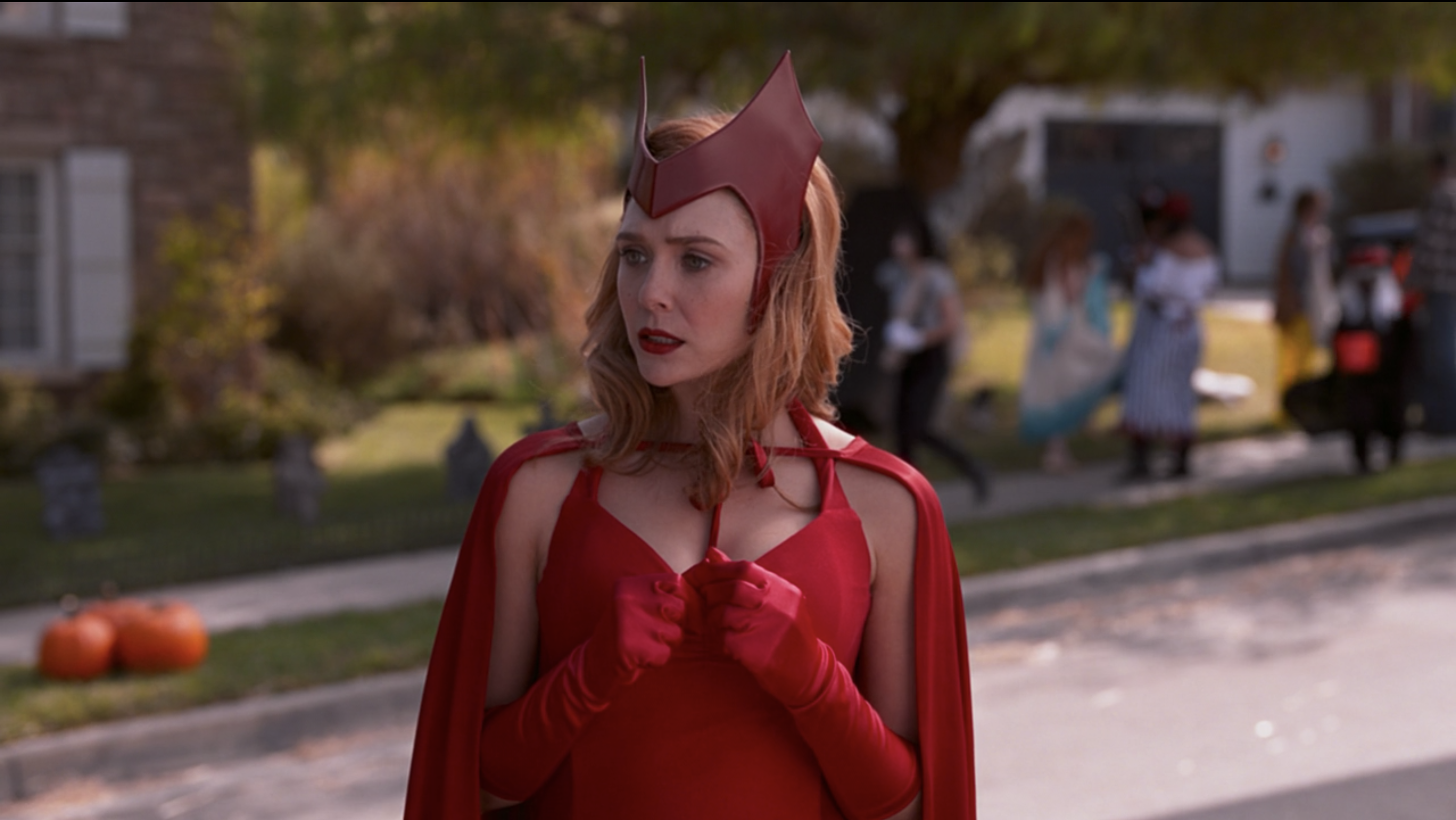Table of Contents Show
Disney +’s WandaVision (2021) presented one of the most intriguing superhero stories we have seen since Netflix’s/Disney +’s Daredevil (2015-2018) (( Goddard, Drew. “Daredevil.” IMDb, April 10, 2015. )). It combined concepts from Jessica Jones (2015-2019) (( Rosenberg, Melissa. “Marvel’s Jessica Jones.” IMDb. November 20, 2015. )) with elements drawn from 2002’s Spider-Man (Sam Raimi), and the result was an extraordinary superhero television miniseries. With WandaVision‘s use of mise-en-scène, directing, and cinematography, the audience was able to capture the zeitgeist of their parents, their parent’s parents, and even themselves all encompassed within a tremendously accomplished grief and heartache narrative.
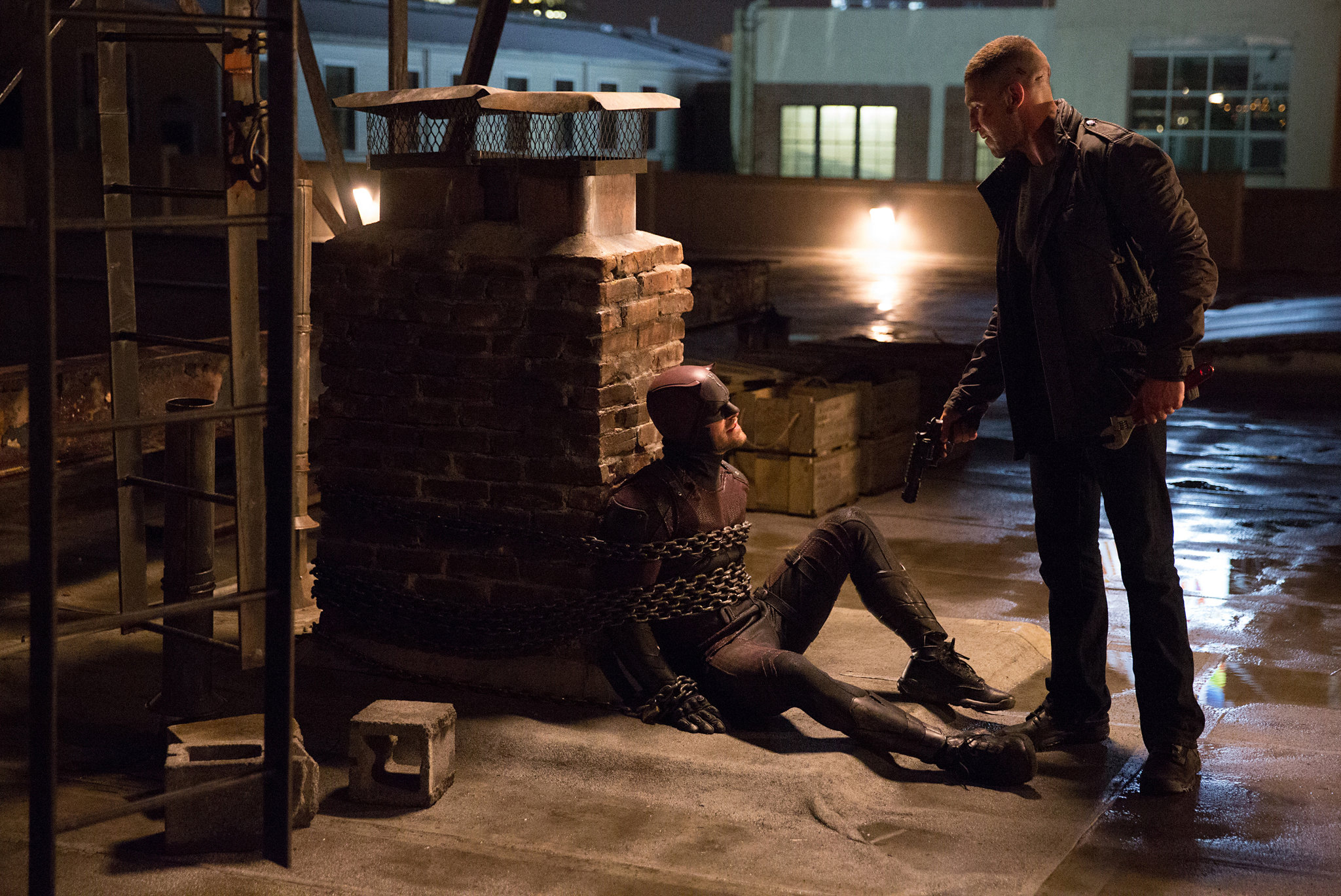
At the time of the series’ release, many spectators felt that the series’ opening episodes were unexpected, jarring, and refreshingly new. Though some viewers disliked them early on, they were successful, and as time went on, the miniseries was able to gain traction for itself, becoming a significant and fascinating piece of the superhero zeitgeist. Despite the series’ debut months, months, ago, the set design remains astonishing, and when it comes to streaming television original content, nothing compares to Disney +’s WandaVision, and I, personally, still miss it months later. (Others, I am sure, feel the same way about both WandaVision and Loki.)
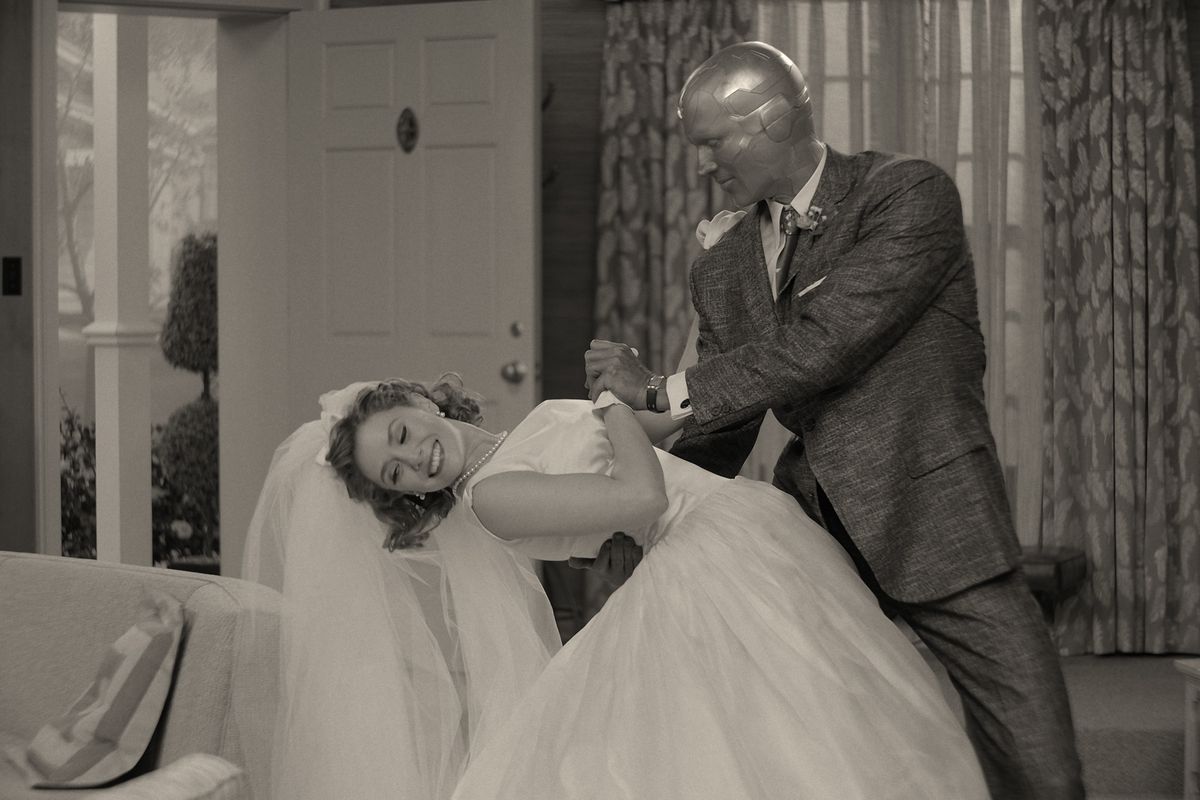
The miniseries, by utilizing each component of filmmaking, (+ by proxy Loki (2021-)) revolutionized the way we view television today; it ultimately allowed itself to exist as an experimental representation of grief and trauma. Over the course of seven episodes, it effectively conveyed Wanda’s trauma through the concept of superhero hyperpostmodernism, thus making the series accessible to viewers of all ages, not solely the generation that can relate. This was achieved by means that extended beyond the use of mise-en-scène, and even beyond the usage of the gaze of a camera.
You are also encouraged to read the previous installment in this episodic series entitled: ‘Eleanor Crain’s Psychological Trauma Painted Throughout The Haunting Of The Hill House‘s “Two Storms.”‘ (( by Shareca. “Eleanor Crain’s Psychological Trauma Painted Throughout The Haunting of the Hill House’s ‘Two Storms’ • The Daily Fandom.” The Daily Fandom, May 27, 2021. ))
Chapter I: The Trauma Of Superheroes
As you can imagine, trauma occurs regularly for superheroes due to the numerous challenges they face on a daily basis, if not every hour. Not only do they massacre citizens with the intention of saving them, but they also cause irreparable damage and global destruction by their very presence — even if it is accidental. (That is why the “Civil War” concept encompasses a lifetime of trauma regardless of the superhero’s allegiance. It is still present in some fraction.) Thereafter, they must move on with their lives and resume saving the world, distancing themselves from any feelings that may result from their actions.
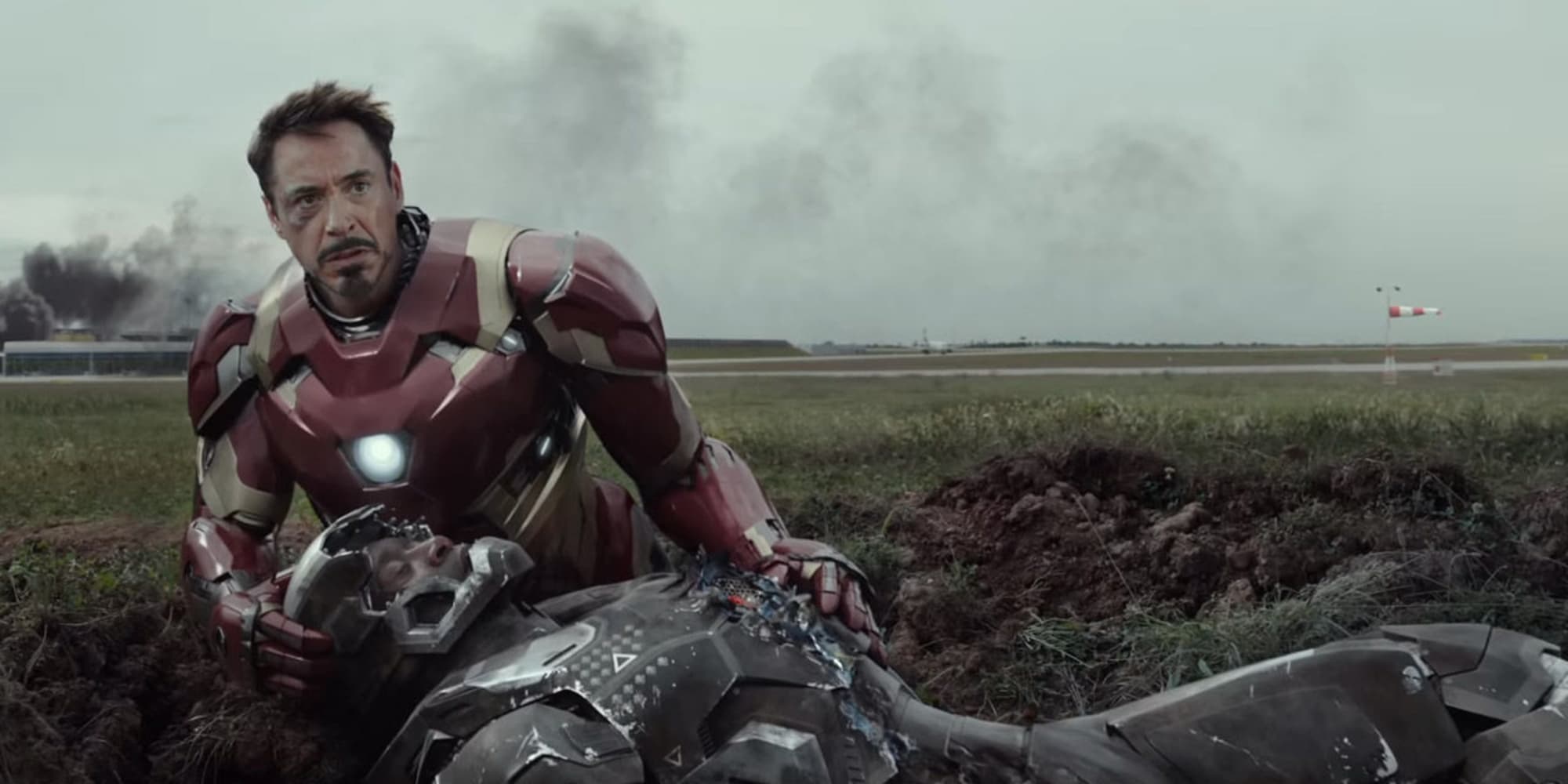
In part, this explains why the meme suggests that superheroes need therapy; the one thing we rarely see them do is engage in any type of therapy, and because they deal with so much more than an average person does, it makes sense that they would experience so many emotions at the same time and need it. It is analogous to the notion that therapists are required to go to therapy themselves. Considering how frequently they are depicted as complex characters with traumatic pasts, it is quite interesting how few superheroes attend therapy, or that the subject is not more commonly discussed in comics and/or other media.
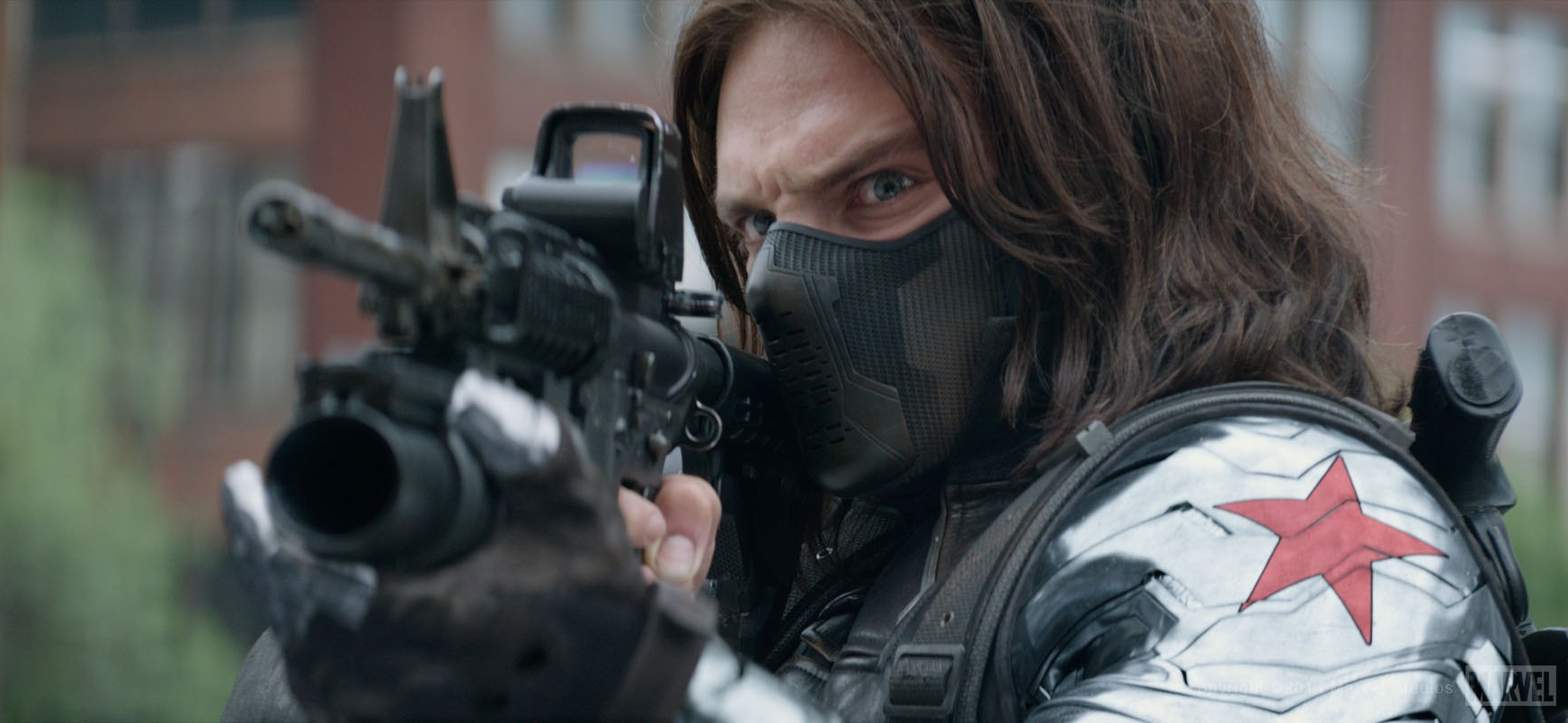
Within the Marvel Cinematic Universe (MCU): Steve Rogers was bullied every single day to the point of being beaten to death — and being willing to be; Natasha Romanoff suffered abuse physically and mentally in a multitude of ways before S.H.I.E.L.D.; The Hulk is verbatim always enraged in some way according to his most famous line: “I am always angry.” (( Joss Whedon, Zak Penn, and Joss Whedon. “The Avengers.” IMDb, April 25, 2012. )) Again, it makes sense that they would need someone — anyone — to talk to; I know I would. I would feel exhausted literally all of the time and not have any clue how to handle it all, especially by myself or surrounded by others with their own baggage. (Even DC has their own version of this with Bruce Wayne and his parents’ murder; Joker, Harley Quinn, Penguin, and Riddler, too.)
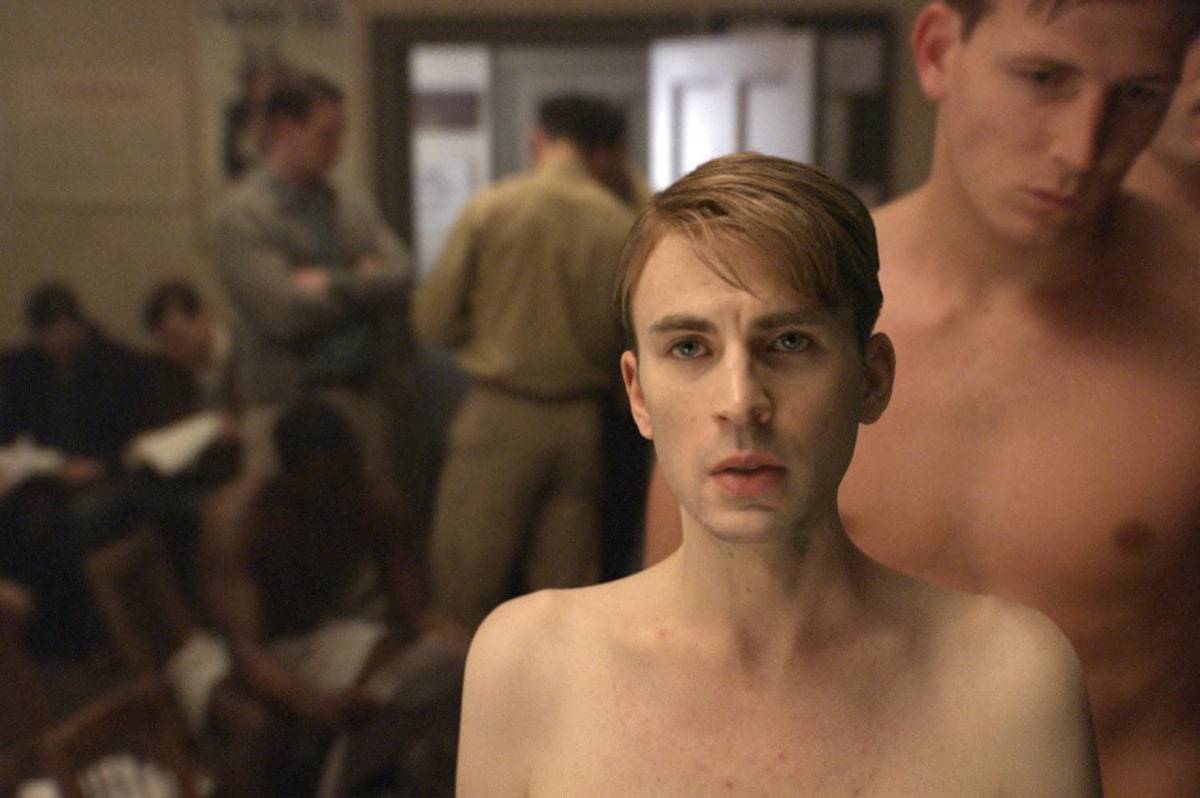
Interestingly enough, what makes this subject so fascinating is that, in many ways, we feel that superheroes ‘being’ in therapy would be far too meta and would make us feel too eerily intimate with the characters. Superheroes differ from us in an important way, and that is the one that most affects us: they have a powerful will and do not give up regardless of the circumstances. Generally speaking, human beings are cowardly because we need to be scared of something to make us human; superheroes are never cowards, and that sets them apart from someone who is purely human. (And why they help us grow from our own trauma and grief.)
And, it is also this element that makes WandaVision a thought-provoking examination of trauma and grief within the context of a superhero. (It is also something Iron Man (2008-2013) covers within its trilogy for Tony Stark. Not as in-depth as all fans wanted, but it was something.)
Wanda Maximoff, Also Known As ‘Scarlett Witch’
In the wake of Infinity War and Endgame, the fictional spear of the MCU has been unable to deal with the after-effects, so everything has been boiling within each character since around 2018/2019 (in real-time, not fictional). Each superhero has been exhausted beyond measure by the trauma they have endured, the lifestyles they have led, and the paths they have taken.
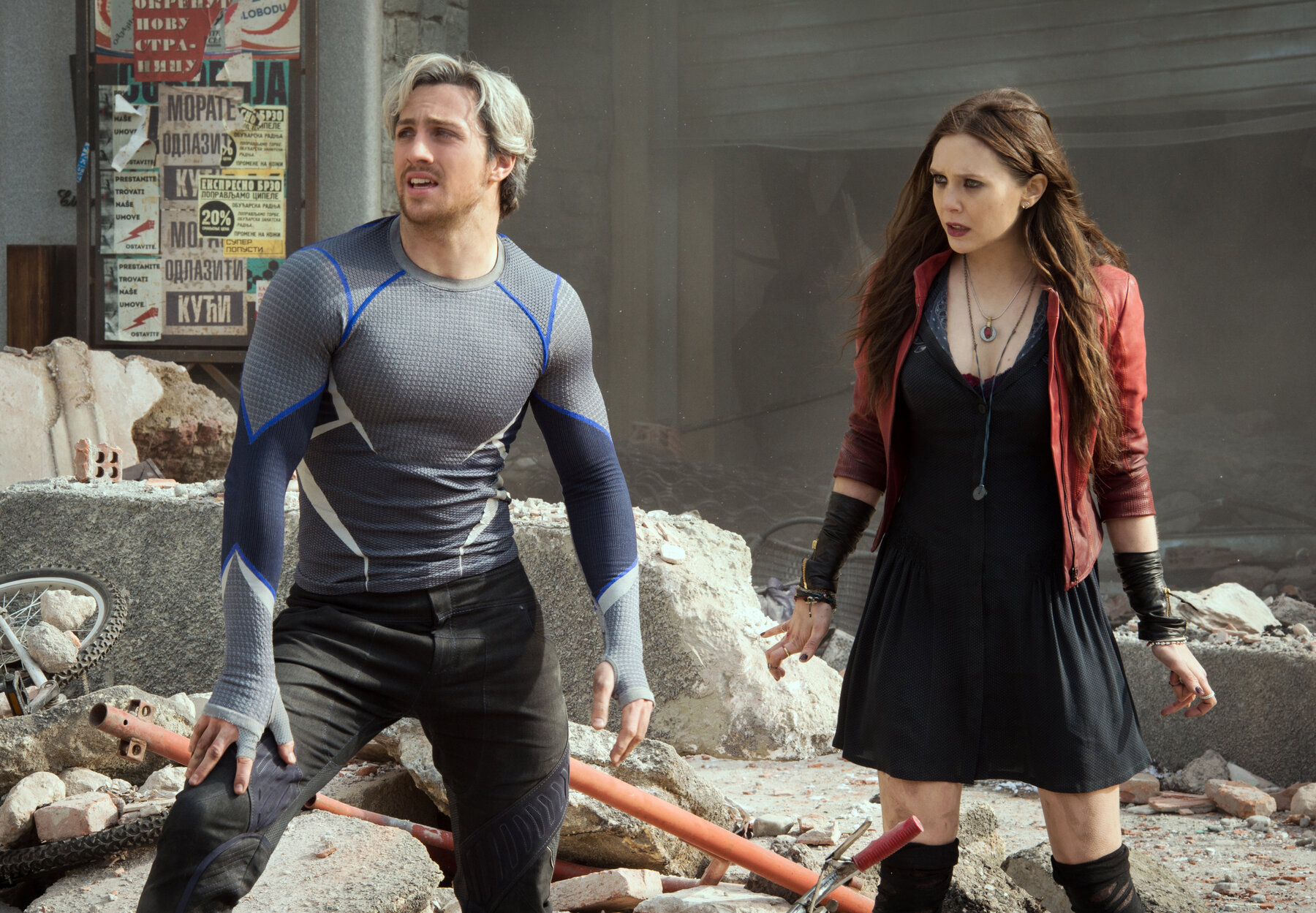
The history of Wanda Maximoff — like Natasha Romanoff — was challenging, and it was only after she joined S.H.I.E.L.D. that she found her calling and the desire to save others. In addition to being a witch, Wanda is also of Sokovian descent; she has a twin brother named Pietro (played by Aaron Taylor-Johnson, in the Avengers films, and Evan Peters, who is a part of the X-Men lore, in the MCU). Both Wanda and Pietro, however, joined HYDRA in order to escape their poverty-stricken homeland when agreed to undergo experiments with the Scepter under Wolfgang von Strucker‘s supervision. As a result, they gained superpowers (because, of course!, they did). The premature stage of Wanda’s powers included: telekinesis, telepathy, and energy manipulation. (But the course of WandaVision made it clear that she is capable of much more than all that has been revealed thus far in the MCU lore.)
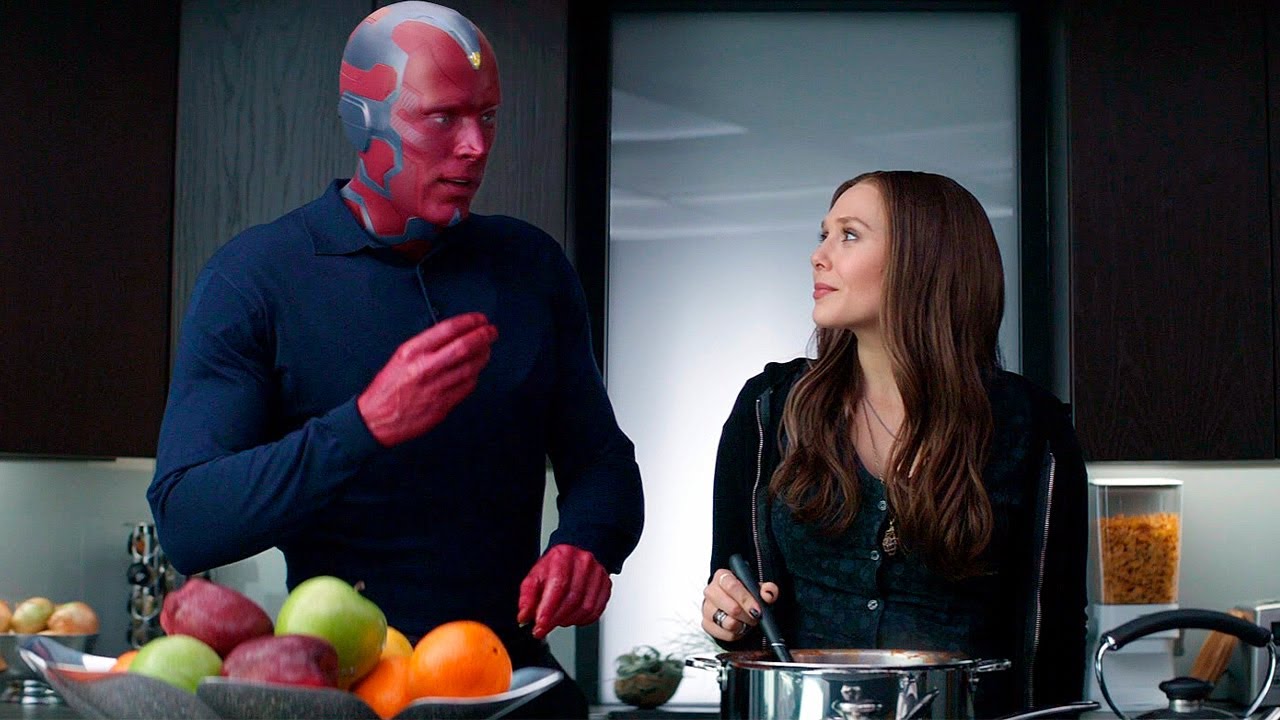
Following the fall of HYDRA, Wanda and her brother Pietro joined forces with Ultron to seek vengeance against Tony Stark for killing their family with his weapons (Whedon, Joss. Avengers: Age of Ultron. 2015). Fortunately, they discovered Ultron’s true intentions, which caused them to depart and exchange sides. As part of the Avengers’ battle to defeat Ultron, the twins fought alongside the Avengers and not Ultron. During the battle against Ultron, Wanda suffered the loss of her brother, Pietro, initiating her long-term grief.
After joining Captain America during the “Civil War,” (Russo, Anthony; Russo, Joe. Captain America: Civil War. 2016) Wanda reconciled with Vision two years after. The pair, Vision and Wanda, moved to Europe and developed a romantic relationship. However, Thanos quickly reappeared, intent on obtaining the Mind Stone, which was the source of Vision’s abilities. Immediately following the ambush, they fled to Wakanda. Wanda joined the resistance when the Order invaded but vanished in the “snap” when Thanos acquired the Infinity Gauntlet.
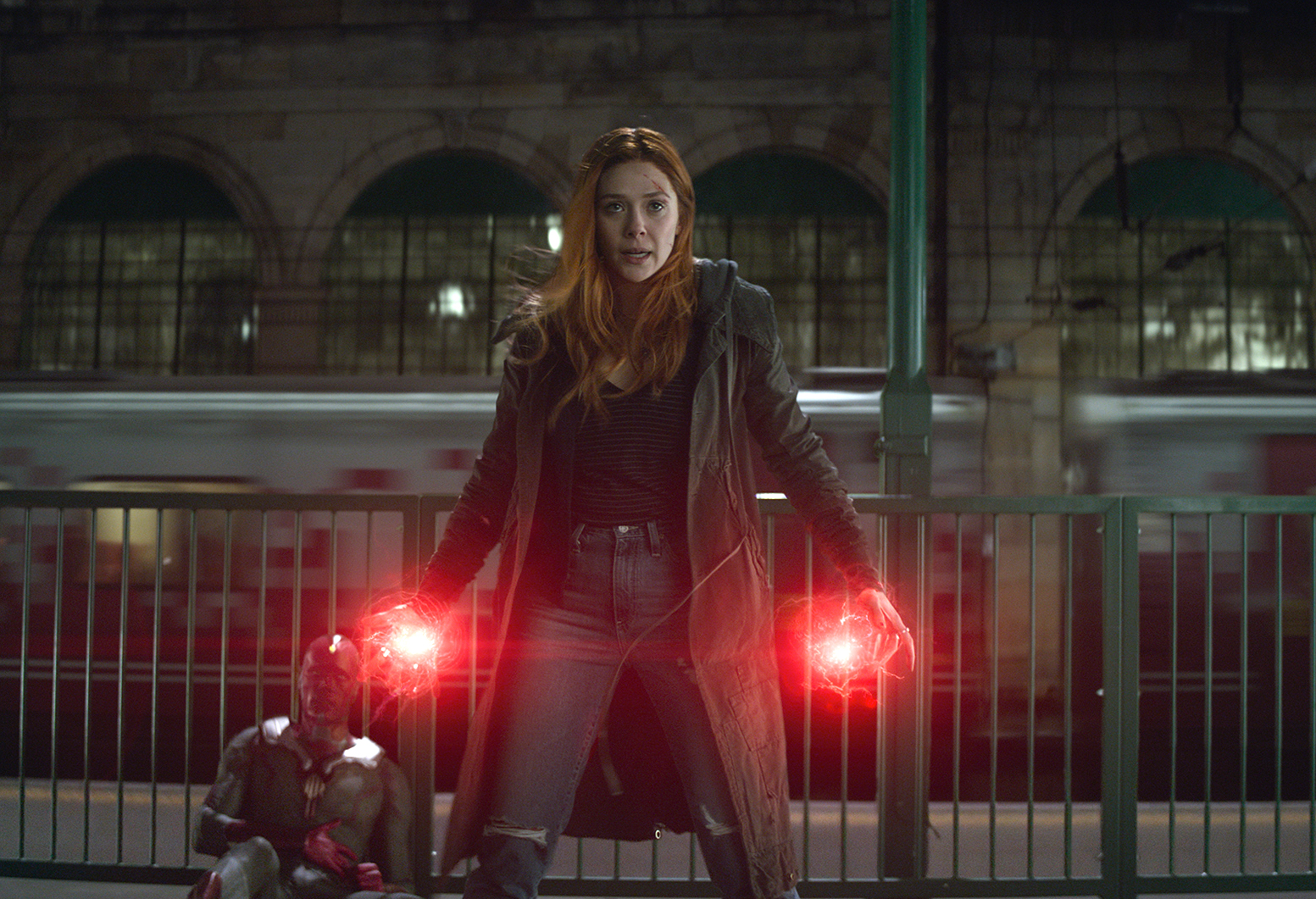
Vision departed from Earth, but Wanda’s effects were reversed in 2023 when she was seen joining the heroes who fought and defeated Thanos and his army during the Battle of Earth (Russo, Anthony; Russo, Joe. Avengers: Endgame. 2019).
Most recently, Wanda appeared in Doctor Strange in the Multiverse of Madness (( Waldron, Michael. “Doctor Strange in the Multiverse of Madness.” IMDb, May 6, 2022. )). (This article will refer only to events occurring before that point in time, but you can read a review of MoM here by Rebecca Radillo).
Chapter II: The Conceptual Framework Of WandaVision (2021)
As the story opens, three weeks after the events of Endgame, Wanda and Vision are settling down in Westview, New Jersey, trying to conceal their true identities. However, as time progresses throughout the series, the couple begins to observe their surroundings changing through periods of time. They then encounter various television popular culture tropes that cause them to become suspicious that all is not as it seems in this small town. (As vague as it can be without any spoilers.)
A Love-Grief-Traumatic Relationship
WandaVision centers on Wanda discovering true love with Vision and discovering a better future for herself (if it were real). Unlike the beginning three to four episodes of the series, the final episodes deal with grief in a more resounding way. Abby Kirby, The Daily Fandom‘s wonderful Fandom section head, says it best:
“The line, said by Vision in a flashback, “What is grief if not love persevering?” struck a chord with WandaVision viewers worldwide and opened a floodgate of emotional tributes. It reflects not only on the show’s themes of grief and love but brings attention to the often-overlooked aspects of the titular characters’ early relationship.”
(( Kirby, Abby. “Marvel’s Acceptance of the Grief Narrative in ‘WandaVision’ — The Daily Fandom.” The Daily Fandom, March 17, 2021. )).
Because that is so, the first few episodes are intended to allow the audience to become attached to Vision and Wanda as a couple who are in love, much like Lucy and Ricky Ricardo (I Love Lucy 1951-57). The audience is introduced to Wanda and Vision as they interact within a nostalgic surrounding reminiscent of Bewitched (1964-72) and I Dream of Jeannie (1965-70). Wanda and Vision are not hindered by their black and white perspective, rather it broadens and enhances their relationship, it reminds us of a simpler time; it is evident from the very beginning of the series, “Filmed Before a Live Studio Audience,” (( Jac Schaeffer, Jac Schaeffer, Peter Cameron, Mackenzie Dohr, Bobak Esfarjani, Laura Donney, Megan McDonnell, et al. “Filmed Before A Live Studio Audience.” IMDb, January 15, 2021. )) that Vision is sincere, loving, and thoughtful. Vision is so romantic that even viewers have fallen in love with him.
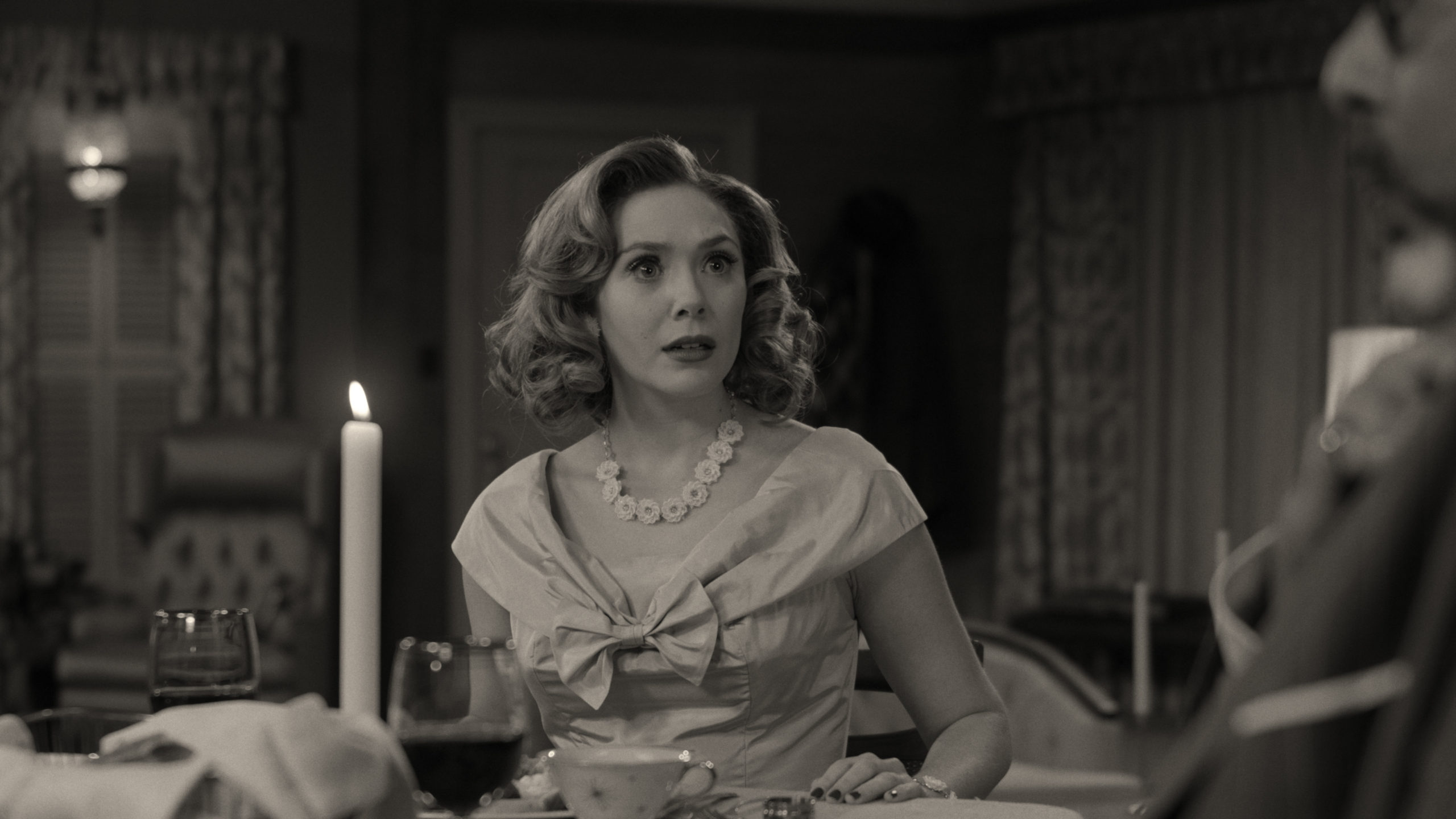
Despite the sitcom-like motifs along with the overly dramatic close-up shots, Wanda and Vision come across as quite radiant as a couple in these early episodes. It is evident from the laugh tracks, the overzealous shots, as well as the magnetic wide shots of them exchanging kisses that they hold a sense of playfulness, warmth, and understanding within their relationship — the one that Wanda envisions. (Basically, they are dorks like us.) It makes watching the series’ conclusion all the more heartbreaking from this early point in the series.
Chapter III: “Breaking The Fourth Wall” (( Squires, Cameron, Jac Schaeffer, Peter Cameron, Mackenzie Dohr, Bobak Esfarjani, Laura Donney, Megan McDonnell, et al. “Breaking the Fourth Wall.” IMDb, February 19, 2021. ))
WandaVision‘s “Breaking the Fourth Wall” presents a powerfully evocative visual narrative of trauma and grief — by applying satire and breaking the fourth wall for the audience, Wanda’s inner feelings are displayed to the viewer (in an unobstructed manner) and in a profoundly meta way. It creates an idealistic hyperpostmodern portrayal of superhero emotional, and mental, turmoil.
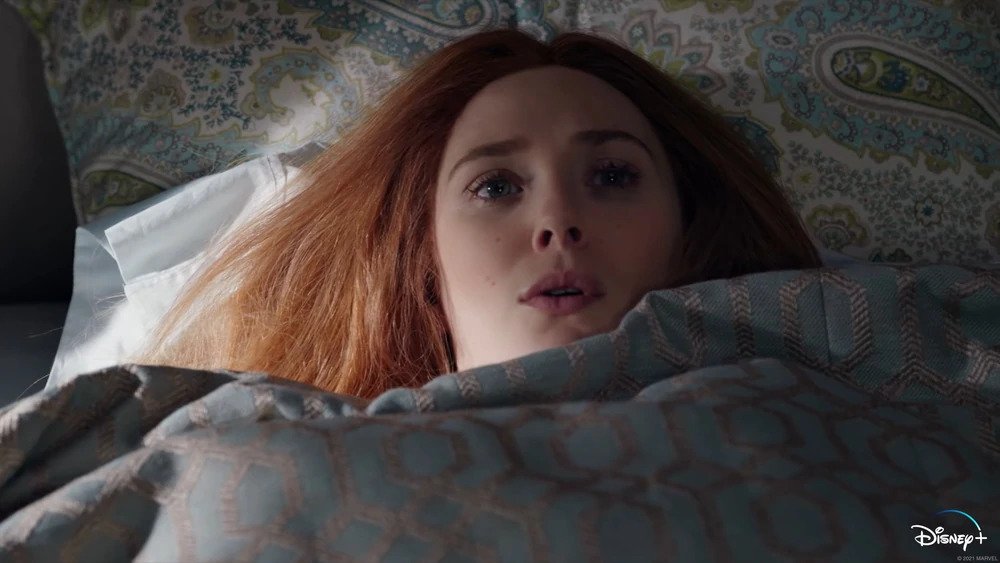
In “Breaking the Fourth Wall,” Wanda’s actions and the lure of “reality television” allow us access to the inner workings of her mind. Although Wanda has no idea what is going on, the viewer is able to see that she is not acting like everything is fine; at least not seriously. By the end of episode seven, Wanda is at her breaking point without any understanding of what has transpired; she feels guilty for characterizing this fictional town (and for reasons unbeknown to her).
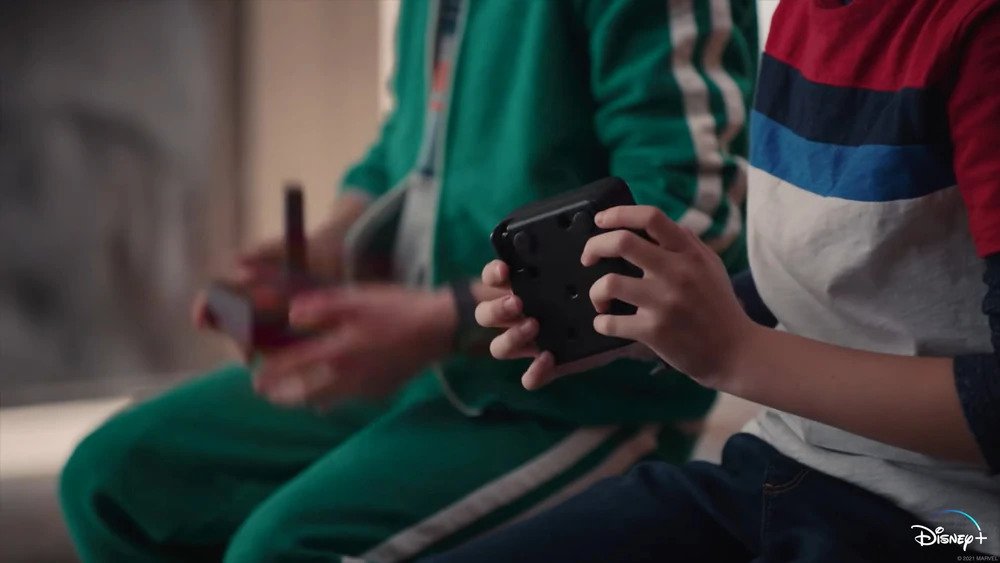
The episode opens with vivid blue coloration that overwhelms the scene. An over-arching blue hue can be seen in various stages of the episode that represents her gloom and despair. All of Wanda’s furniture, the walls, the cereal box, and the entire backdrop are somber/blue in color. Wanda is, as a result of her sadness, depression, and a profound sense of guilt and trauma, suffering from suffocation. Wanda is overwhelmed by everything that has come to light, and knowing that it is her fault makes it profoundly worse.
Before: “Breaking The Fourth Wall”
- In Episode Three, “Now in Color,” (( McDonnell, Megan, Jac Schaeffer, Peter Cameron, Mackenzie Dohr, Bobak Esfarjani, Laura Donney, Megan McDonnell, Cameron Squires, and Jac Schaeffer. “Now in Color.” IMDb, January 22, 2021. )) Wanda says that she will never be separated from Vision again, indicating that she is aware of her grief to some extent.
- In Episode Four, “We Interrupt This Program,” (( Bobak Esfarjani, Megan McDonnell, Jac Schaeffer, Peter Cameron, Mackenzie Dohr, Bobak Esfarjani, Laura Donney, Megan McDonnell, Cameron Squires, and Jac Schaeffer. “We Interrupt This Program.” IMDb, January 29, 2021. )) Wanda states that she does not know how all of this happened, indicating that she is aware there is something going on, but unsure as to what.
- Wanda has encountered moments of confusion and terror before the appearance of “Breaking the Fourth Wall,” as she attempts to ascertain how she arrived at this point, and what is taking place around her. In addition to this, Vision is also attempting to formulate his own conclusion as to what this town could be, as well as why it only exists in a limited area surrounding them.
The Filmmaking
Wanda wakes up after oversleeping to discover that her sons are complaining about the voices in their heads being too loud (as their video games continue to transform by the decade). Another indication that her magic has become out of control. In bed, she realizes two additional things: Vision is not present in the bed with her, and she is still wearing her Scarlett ensemble.
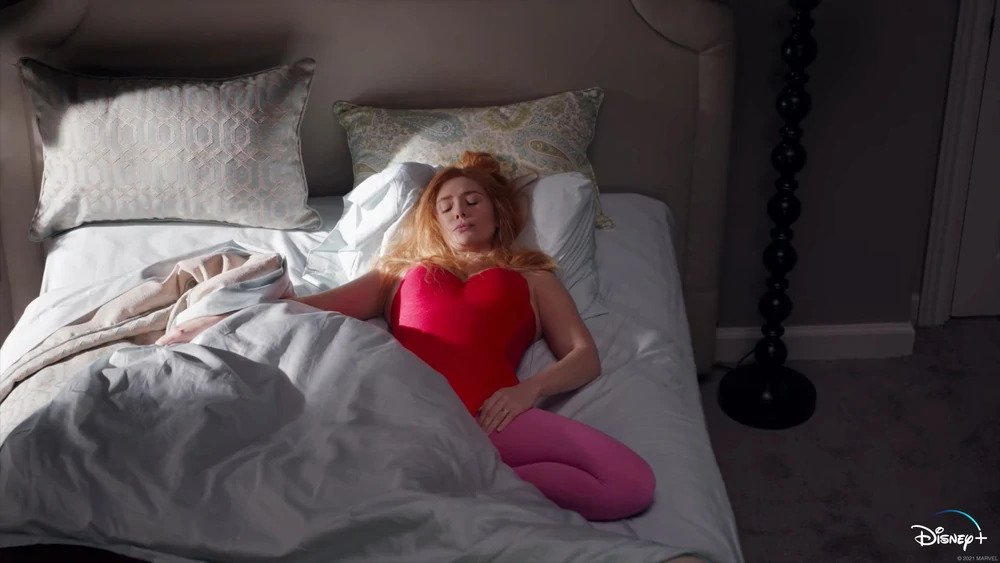
Following this (as seen in her ‘Talking Head’ segment that mirrors reality television) she changes into “normal clothes” indicating that she does not feel like herself. This is monumental because it means that there is a sense of detachment between herself and Wanda, something that was not present before. Due to Scarlett’s magic being out of control, Wanda feels fearful about what she can do, what she can accomplish, and how she is unable to control this aspect of herself. If Scarlett was able to create this world, she is far more powerful than Wanda thinks, and Wanda is beginning to acknowledge this as Wanda.
“Talking Head” Sequence / Meta Reality Television
Wanda’s environment is depicted to be erratic as Wanda’s hand-held camera is unable to stabilize as it constantly and abruptly zooms in and out on various facial expressions. Yet — after she gets out of bed, she does a “talk segment” and explains, to us, that she is on a “quarantine-style staycation.” (This translates to — she is avoiding all of her responsibilities in order to stay at home, which is an obvious sign of depression and stress as she is seen as lethargic the entire episode.) As she remarks,
“Look, we have all been there at some point, right? Letting fear and anger get the best of us, purposely expanding the perimeters of the false universe we constructed.”
(( Squires, Cameron, Jac Schaeffer, Peter Cameron, Mackenzie Dohr, Bobak Esfarjani, Laura Donney, Megan McDonnell, et al. “Breaking the Fourth Wall.” IMDb, February 19, 2021. ))
She earnestly questions her own sanity in the close-up shot with a pondering expression and what it might mean if it is true. (Despite the fact that it is true, there is an element of denial in this episode by the use of mockery and evading the truth.)
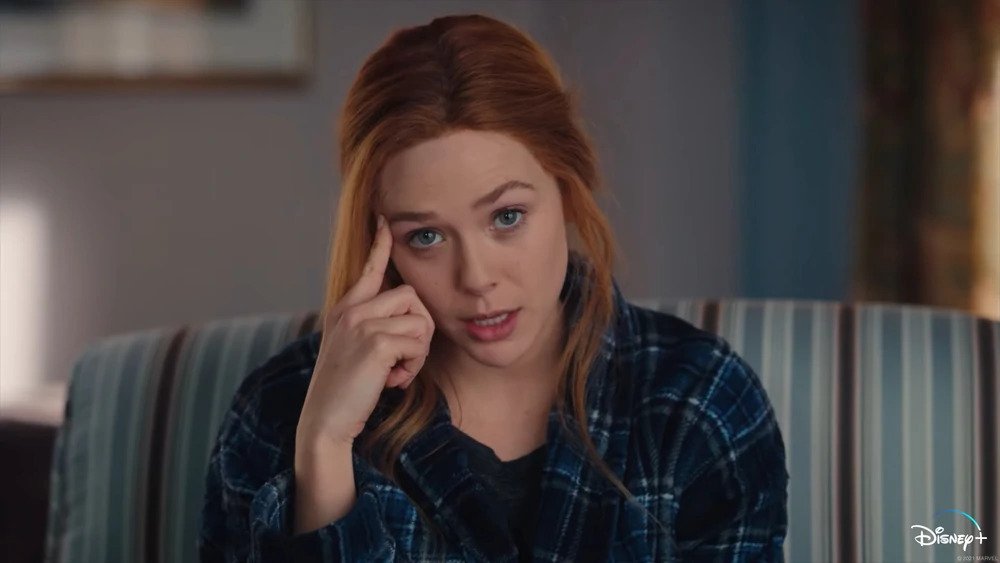
As the audience tries to determine if the satire is genuine or a mask for Wanda’s real emotions, the adamant blues dominate the frame, disembodying Wanda in an atmosphere of dismay. The dreariness of Wanda’s “A whole day… just to myself,” suggests her unhappiness with having to contend with the intrusiveness of her thoughts throughout the day. According to Wanda, this is the punishment for doing wrong with her magic, as the ultimate punishment is to be trapped inside one’s mind. As s victim of her own grief and trauma, she is unable to deal with it; this is reflected in her lack of dressing, inattention to the children, and her use of magic — which she does not care if anyone sees her do in this particular episode.
Kitchen Sequence / “A Case Of The Mondays”
While the camera pans on Wanda as she enters the kitchen to prepare breakfast, her two sons, Tommy and Billy, are rather perplexed as she looks ‘normal,’ which is not typical of Wanda’s usual attire. As she reaches into the refrigerator, an extreme close-up is delegated when she picks up the milk. When the camera abruptly zooms out, Wanda is seen again going to grab the cereal, and, oddly enough, Wanda’s cereal, Sugar Snaps, is also blue in this sequence. In a sense, she is “eating her sorrow.” It — grief, sorrow, regret, disarray — is constantly suffocating her no matter the room she enters. She is in the darkest state one can be, especially with Vision missing from the bed this morning. It feels as though even he is detached from her.
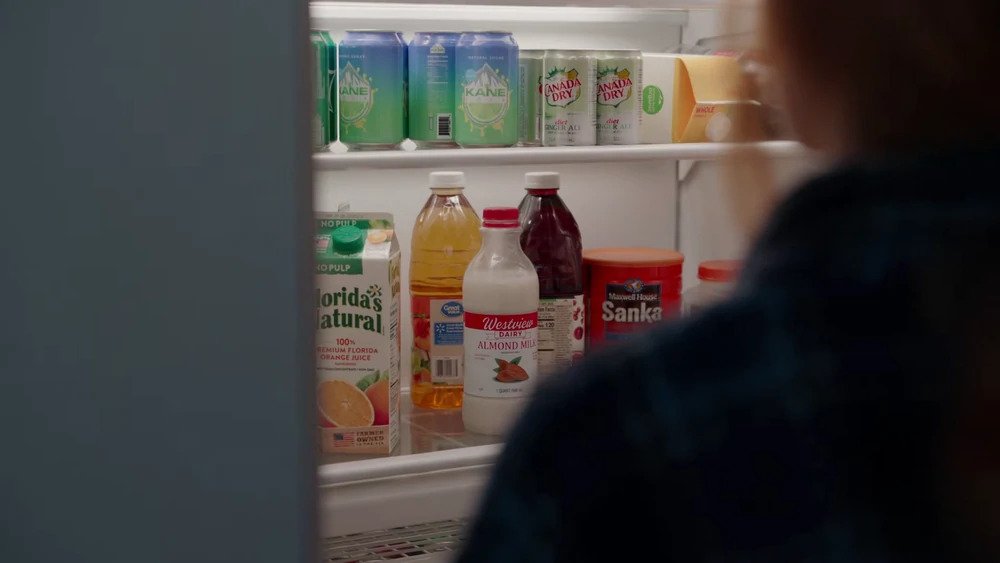
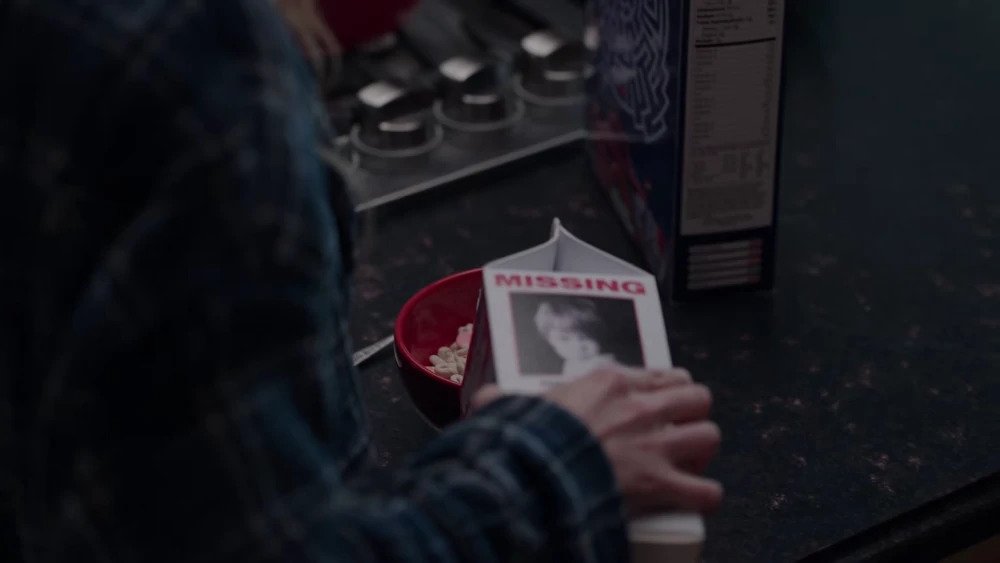
As Wanda turns around to grab the cereal, the milk has miraculously morphed into Vitamin D in a carton. A close-up shot, then, encompasses the frame as Wanda carefully monitors the milk to ensure she is not actually going absurd (but we all know she really is, as are we). As soon as it is set back down, it changes back to the glass variation. Yes, this is a consequence of the decades, however, it is also a consequence of her magic that has become out of her own control; it is apparent in her expression that she does not know how this is happening. (Although we know it is Agatha by the end.) Wanda decides to ignore the problem in a humorous manner by sniffing her cereal, thus ignoring the reality that her magic is affecting everything around her without her consent.
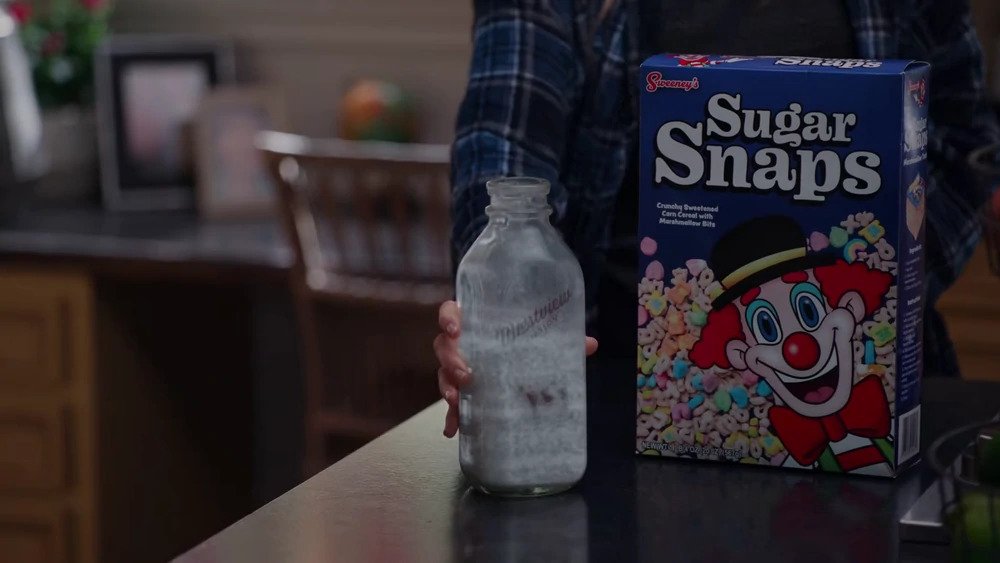
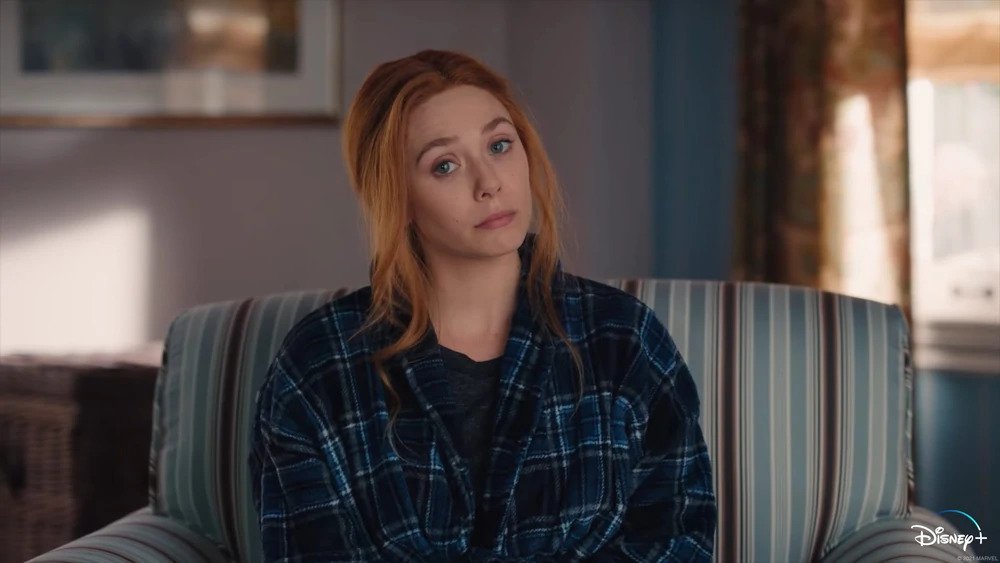
But as she is asked about it in her interview “talk segment,” as one would in a Big Brother or Bachelor episode, she replies, “I am not sure what that is about.” (( 03:56 — Squires, Cameron, Jac Schaeffer, Peter Cameron, Mackenzie Dohr, Bobak Esfarjani, Laura Donney, Megan McDonnell, et al. “Breaking the Fourth Wall.” IMDb, February 19, 2021. )). She again tries to deflect by stating that it “must be a case of the Mondays.” (( Squires, Cameron, Jac Schaeffer, Peter Cameron, Mackenzie Dohr, Bobak Esfarjani, Laura Donney, Megan McDonnell, et al. “Breaking the Fourth Wall.” IMDb, February 19, 2021. )). When she says “the case of the Mondays,” the extreme close-up that zooms on her face conveys a haunting impression; the expression is one of fear, terror, and bafflement at the same time.
Vision / “Deattachment”
Wanda deflects the fact that Vision is not present at home, telling the boys that “if he does not want to be there, she cannot do anything.” Her apparent defiance and distress with Vision’s absence are resonant throughout the episode. Shortly thereafter, she explains that she has no answers for what is happening and without Vision, she seems to be lost.
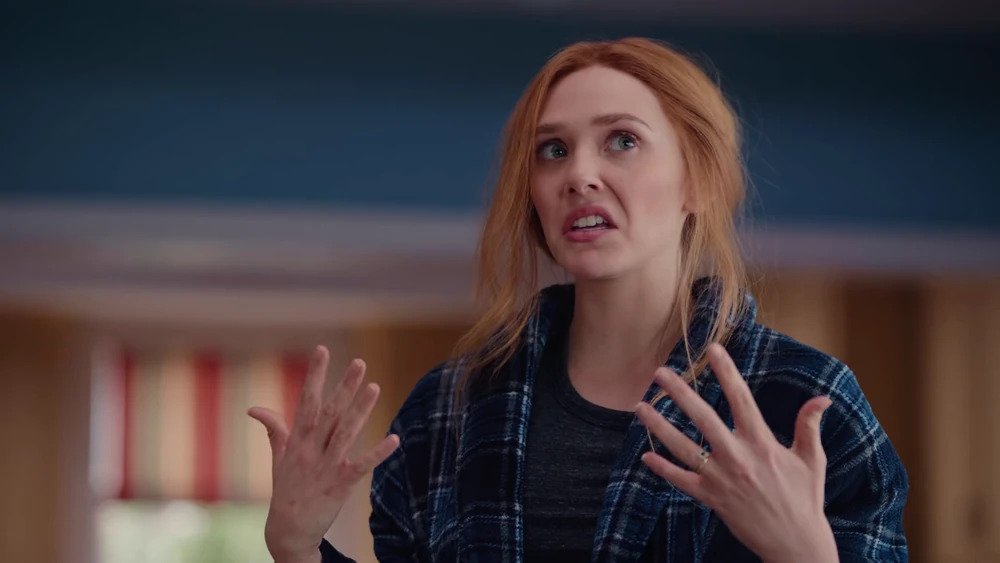
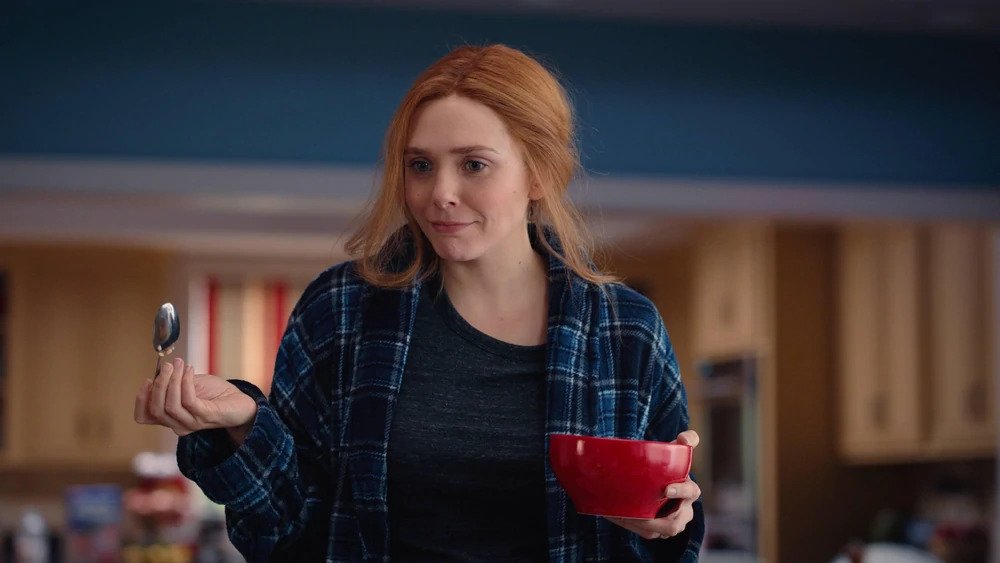
Wanda confesses that she does not know all of the answers and that, despite being Tommy and Billy’s mother, she does not know everything — and, right now, she knows nothing. Wanda quips that “everything is meaningless,” providing further insight into her dismay. As she quips about being “too harsh” in her ‘talking head’ segment, she deflects once more by suggesting that Vision is made of vibranium.
Mise-En-Scène / Cinematography
It is impossible to avoid the fact that Wanda appears to be losing her mind as evidenced by her systematic close-up shots, her lax attitude, and her apparent lack of concern (by using her magic at any time and place); once again, this is depression in its most virulent state. Wanda does not attempt to conceal the fact that she uses magic in this episode, at least not in front of Agatha. When she opens the door to indicate that she does not wish to get up, she is doing so without contemplating the consequences or being mindful as she has been previously.
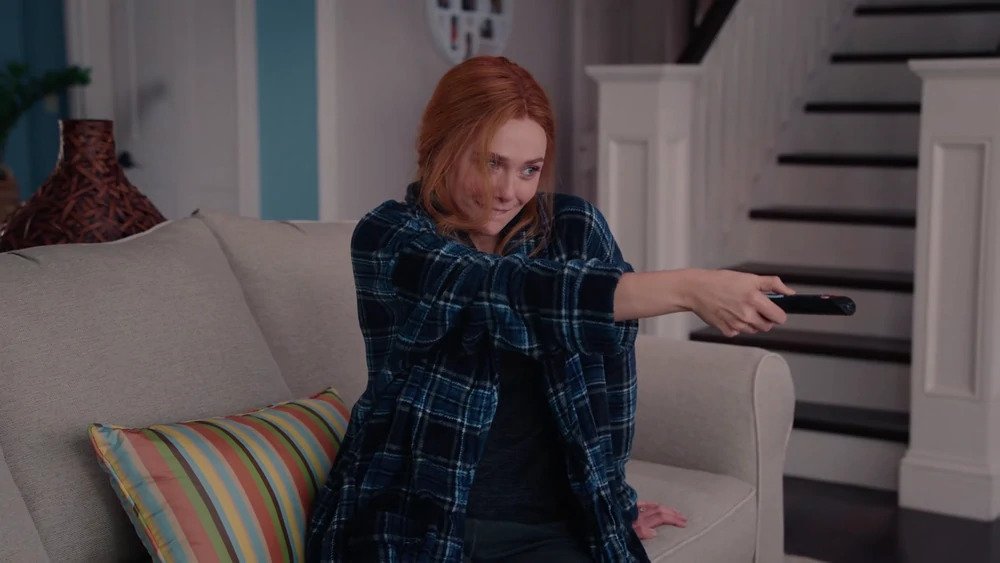
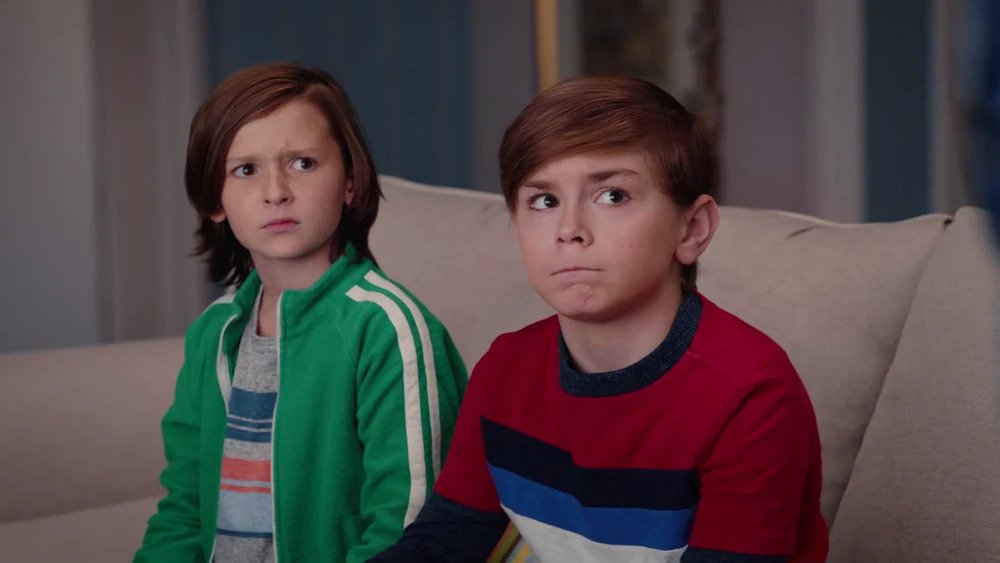
But as her mise-en-scène changes, she becomes increasingly concerned. While she is eating her cereal on the couch, the TV changes, the fireplace shifts, and the entire living room changes. Despite repeating “I am fine,” the audience knows that she is not fine; the extreme close-up shot indicates she is on the verge of sobbing.
The last ‘Talking Head’ Segment Wanda gives in this episode is when she says,
“I don’t understand what is happening. I don’t understand… why it all seems to be falling apart and why… I can’t fix it.”
(( Squires, Cameron, Jac Schaeffer, Peter Cameron, Mackenzie Dohr, Bobak Esfarjani, Laura Donney, Megan McDonnell, et al. “Breaking the Fourth Wall.” IMDb, February 19, 2021. ))
Although the segment ends on a lighter note, it is important that Wanda admits these problems as they are indicative of her growing realization that something is wrong. Whether she is aware she is grieving is another issue, but her awareness of something going wrong is a sign of her past, which will be explored in subsequent episodes.
Chapter IV: The Future Of Television: Disney +’s WandaVision (2021)
As WandaVision‘s entire miniseries illustrates Wanda’s trauma and grief in a variety of ways, “Breaking The Fourth Wall” is an episode that marks the beginning of Wanda’s journey of self-discovery. As soon as Agatha reveals to her what has been happening, she begins a transformation to understand how she came to be where she is and how she will move forward now knowing it. In “Breaking The Fourth Wall,” this is the first time Wanda is acknowledging that none of this is as real as she believes it to be.
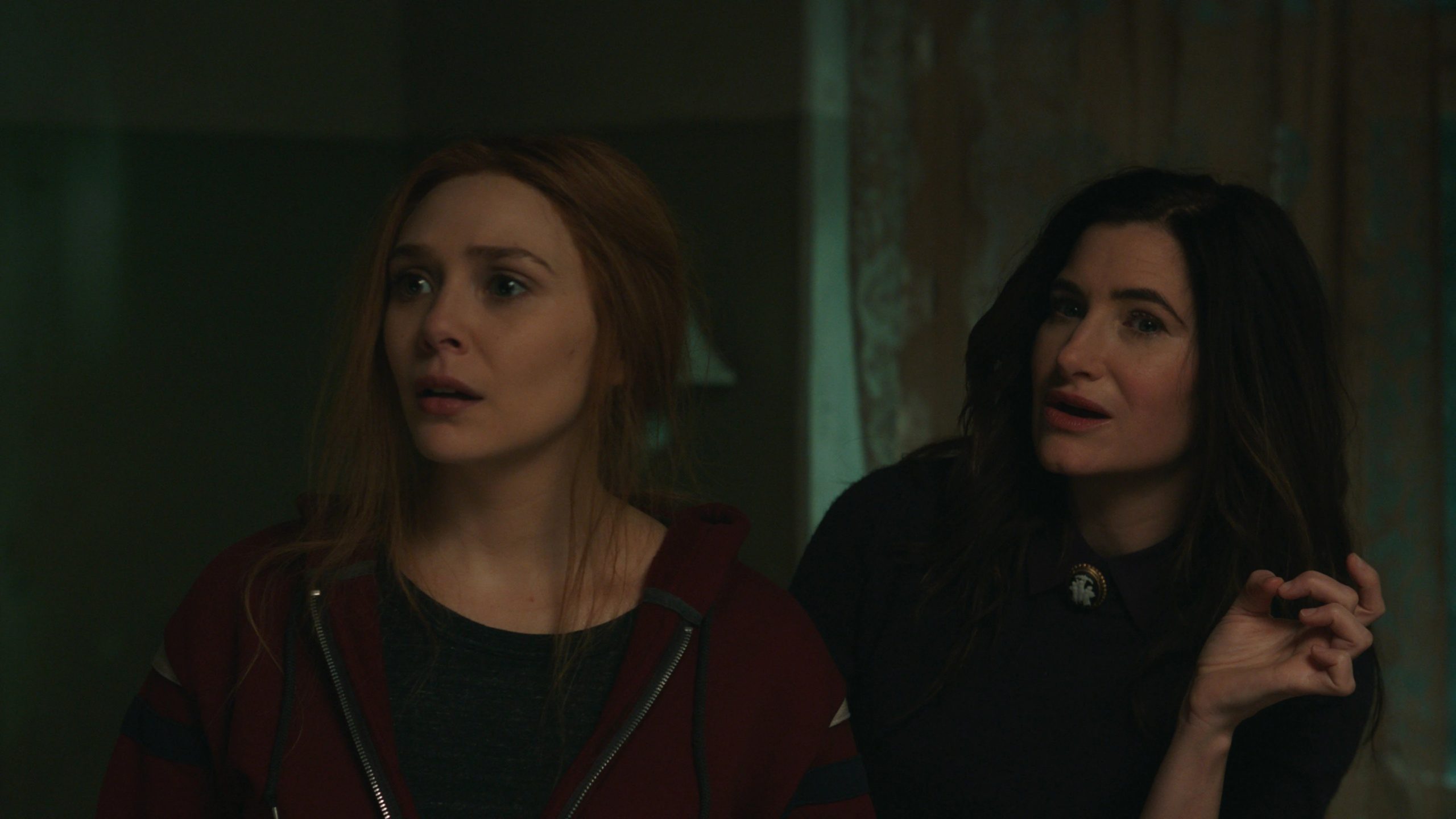
Every time I rewatch WandaVision, I am blown away by the level of emotion it evokes; there is so much love at its core. It is difficult to describe Wanda as anything less than remarkable.
